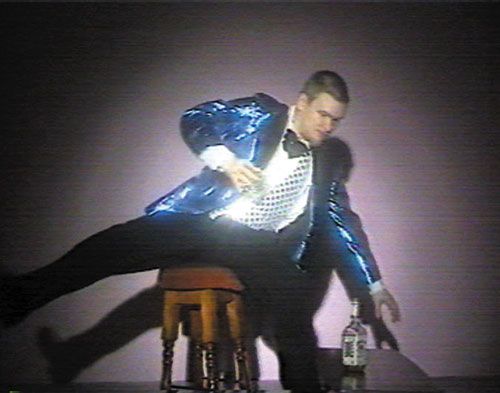In the following posts I will focus on the spread of the video loop in our social networks, but in this post specifically I would like to look at one of the digital image formats that have gained a lot of popularity during the last two years; the GIF. TheGraphics InterchangeFormat is a bitmap image format created in 1987 which supports up to 8 bits per pixel and which is produced to create animations. GIFS have been around for 25 years but it is social media that has brought It back to life in all its splendour thanks to its  portability and compression. GIF is embedded of a variable number of frames that play automatically one after each other in order to create a senseof movement. This at the same time is looped, giving the impression of an everlasting motion.This moving image format has recently given rise to all type of new tendencies among internet users and it has even aroused the curiosity of artists who use it as an artistic expression itself. We find one of the main reasons of its current success in Trumblr (a microblogging site) although they circulate in many types of platforms.
portability and compression. GIF is embedded of a variable number of frames that play automatically one after each other in order to create a senseof movement. This at the same time is looped, giving the impression of an everlasting motion.This moving image format has recently given rise to all type of new tendencies among internet users and it has even aroused the curiosity of artists who use it as an artistic expression itself. We find one of the main reasons of its current success in Trumblr (a microblogging site) although they circulate in many types of platforms.
It is in the constant repetition of the same clip (the same action, gesture) where I find some parallels between GIFS and some of the early works of artist Peter Land. Peter Land is a Danish artist that works in a multidisciplinary range of techniques although I would just like to focus on the first videos he made in the late 90’s. For instance, in Pink Space (1995) he plays the role of an artist who at the moment of going up on stage and sitting down, falls down once and again. In the same way, in Staircase (1998), he appears falling down the stairs time after time as a sort of loop.

As Peter notes during an interview, the very first ideas behind these videos come from the influence of slapstick comedy in silent cinema, pointing out an example of an scene of Laurel & Hardy in which they had a massive pie fight at the end of the film. Under this premise, he wonders if it had been funny if the entire movie would had consisted of a repetition of the same gag: “And I started thinking… what if the entire film would had only been about people throwing cakes into each other’s faces? What about 100 scenes only with that, would it stay funny or would it turn into something else?
Peter Land’s work is also influenced by the Theatre of the Absurd and the belief that human existence has no specific purpose or meaning. Indeed, one of its characteristics was to use repetitive actions to the point the play became absurd and thus meaningless.
I’m something quite different, a quite different thing, a wordless thing in an empty space, a hard shut dry cold black place, where nothing stirs, nothing speaks, and that I listen, and that I seek, like a caged beast born of caged beasts born of caged beasts born in a cage and dead in a cage, born and then dead, born in a cage and then dead in a cage, in a word like a beast Samuel Beckett , The Unnamable
Peter Land depicts all these ideas by isolating a gag (for instance, falling down the stairs) and then repeating it to the point it turns into something else that has nothing to do with the funny scene of the slapstick comedy. As a consequence, by decontextualizing , repeating and presenting it as a new object, the action becomes something absurd, meaningless, without purpose and even sad, as it represents a constant failure; a struggle that is never surpassed, submitted to the endless circle of repetition. It is the very idea of the progress what Peter Land explores in his videos. A man in a vulnerable situation that has to face his repetitive failures and accept the meaningless of his experience. In a great article about the power of the loop Chris Baraniuk writes:
The complete absence of teleology and catharsis within the loop destroys our sense of the self, our idea of progress, our intention to accomplish anything.
Repetition can be understood as an imitation of a gesture with a small variation, as happens with Peter Land’s videos, or as an exact replica of something , like a GIF. The popularity of GIFs is spreading so widely that we can actually find all type of GIFs taken from a broad range of content: movie scenes, music videos, YouTube videos etc. Anything now is susceptible to become a GIF: clumsy actions, accidents, violence, embarrassing situations, even the most unnoticed gesture in a movie. Every clip now can be looped to the point of absurdity, banality and nonsense. The loop has the power to trap you, to absorb you, to get into your mind and don’t let you stop watching it, to manipulate its meaning until it ends with it. Its hypnotic appearance makes you enter in a sort of meditation state with which we inexplicably empathize.
One of the blogs related to some of the previous statements and that I personally find hilarious is Whatshouldwecallme, a blog made on Trumbl that uses GIFs to portray humorous moments of everyday life. GIFs are generally taken from movie scenes, TV series or animals and they go together with some text that turns them into very funny clips. Whatshouldwecallme portrays vulnerable situations in life in which we all sometimes find ourselves involved; embarrassment, exaltation of happiness, ridicule, clumsy gestures, exaggeration, anger, sadness, and so on. As happens with Peter Land’s falls, Whatshouldwecallme represents these personal experiences of daily life in which we feel somehow absurd; uncontrolled situations that portray human beings as meaningless and with which almost everyone empathize. Whatshouldwecallme is about playing “the loser”, trapped in the loop of a fragile experience from which you can never get away, until it becomes senseless and then easily appropriated by humour.
“…it becomes about this very human condition of existence…it’s also very much about the loss of control, this feeling that you are not the master of yourself anymore, something from the outside is somehow interfering with you, not in the psychotic way, but more like in a social way that makes it impossible for you to feel that you are directing your own actions” Peter Land
The border between comedy and tragedy is very thin, so is the line between absurdity and reasonability. The loop is here to question their own limits.
WHEN MY FRIEND ARE ALL JUST REALLY EXCITED
TO DO SOMETHING BUT I AM NOT JUST IN THE MOOD



